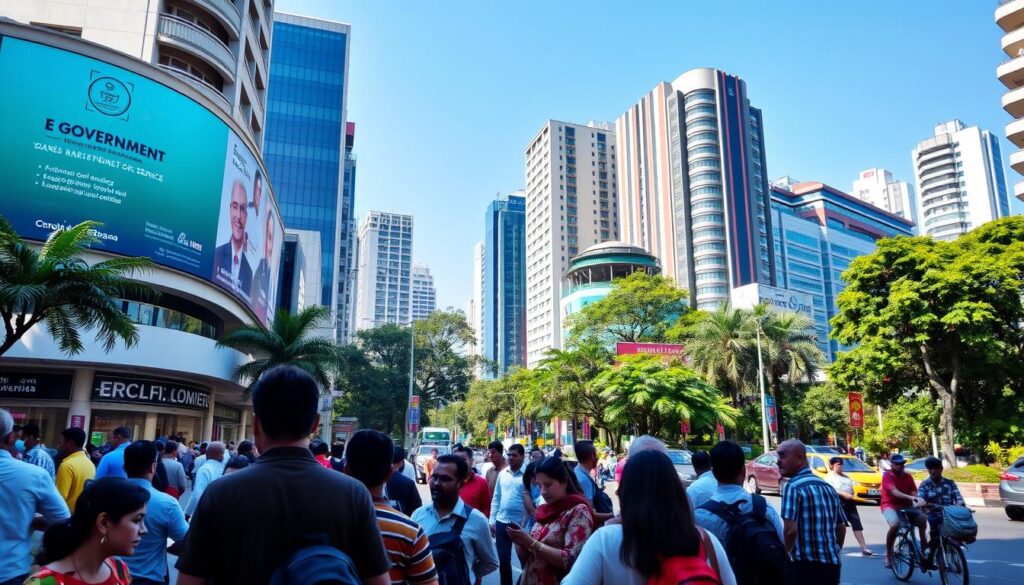Sri Lankan Artists Exhibit at Venice Biennale 2024
The 60th Venice Biennale in 2024 will showcase art from around the world. Sri Lankan artists will display their unique styles and viewpoints at this famous event. This exhibition offers a chance for cultural exchange and dialogue.
The Venice Biennale has a long history of featuring artists from many countries. Including Sri Lankan artists shows growing recognition of their contemporary art. George Keyt, a famous Sri Lankan painter, blended European and South Asian styles in his work.

The 2024 Venice Biennale will feature 331 artists, more than the 213 in 2022. It will have two main sections: “Nucleo Contemporaneo” and “Nucleo Storico”. These focus on contemporary and historical artworks.
The “Nucleo Storico” section will explore global modernisms and modernisms of the Global South. It will look at portraiture, abstraction, and Italian diaspora in the Global South.
Sri Lankan artists at the Venice Biennale 2024 show the country’s thriving art scene. They can share ideas with artists from other countries. This exchange helps enrich global art discussions and understanding.
Key Takeaways
- Sri Lankan artists will exhibit their works at the prestigious Venice Biennale in 2024, showcasing contemporary Sri Lankan art on the international stage.
- The inclusion of Sri Lankan artists in the Venice Biennale highlights the growing recognition of the country’s thriving contemporary art scene.
- The exhibition will feature a record number of 331 artists, divided into two main sections focusing on contemporary and historical artworks.
- The participation of Sri Lankan artists provides opportunities for cross-cultural dialogues and collaborations with international artists.
- The Venice Biennale serves as a platform for cultural representation and the exchange of diverse artistic perspectives.
Contemporary Sri Lankan Art Takes Center Stage at Venice Biennale
The Venice Biennale 2024 will showcase Sri Lanka’s vibrant contemporary art scene. This prestigious exhibition offers a global platform for emerging and established artists from the island nation.
Celebrating Artistic Diversity and Cultural Representation
Sri Lankan artists will represent their country’s rich cultural heritage at the Venice Biennale. The event features 88 national pavilions and attracts art enthusiasts worldwide.
These artists will contribute to discussions on South Asian art in the global scene. Their participation highlights the importance of diverse cultural perspectives in contemporary art.
Showcasing Emerging Talents and Established Artists
Renowned sculptor Chandraguptha Thenuwara will present his work “Covert” at the Palazzo Mora. His participation demonstrates the recognition of established Sri Lankan artists internationally.
The Biennale will also serve as a launchpad for emerging talents. It offers them exposure to a global audience and opportunities for cross-cultural collaborations.
This event marks a pivotal moment for contemporary Sri Lankan art. Artists will showcase their unique styles and address important social, political, and cultural issues.
Sri Lankan Artists Exhibit at Venice Biennale 2024
Sri Lankan artists will shine at the Venice Biennale 2024. They’ll showcase their unique artistic narratives and styles. This event celebrates global contemporary art practices.
Exploring Unique Artistic Narratives and Styles
Chandraguptha Thenuwara’s “Covert” was featured at the 2022 Venice Biennale. The eight-foot-tall iron sculpture took a year to make. It uses symbols and drawings that reflect Sri Lanka’s context.
Thenuwara’s 25-year art career critiques parliament and government. His work balances visual appeal with deep themes. He uses imagery like Lotus Buds, Stupas, and Barbed Wire.
Engaging in Cross-Cultural Dialogues and Collaborations
The 2024 Biennale will spark global dialogues for Sri Lankan artists. It’ll showcase their rich, diverse contemporary art. This exposure will boost understanding of Sri Lanka’s artistic heritage worldwide.
The Biennale focuses on new participants and inclusivity. It features Indigenous and queer artists in the Nucleo Contemporaneo section. The Disobedience Archive shows works by 39 artists from 1975 to 2023.
The Impact of Sri Lankan Art on the Global Art Scene
Sri Lankan artists are making waves at the Venice Biennale 2024. Their unique talents are gaining worldwide recognition. This event showcases diverse artists, from self-taught creators to established masters.
The Biennale is a hub for cultural exchange. It allows Sri Lankan artists to connect with international peers. They can engage in cross-cultural dialogues and collaborations.
The exhibition features various art forms. These include installations, textiles, sculptures, and paintings. A standout piece is the mural “Diaspore” (2024).
Indian artists Karnika Bai, Shanthi Muniswamy, and Jyothi H created this work. It’s part of the Aravani Art Project. The mural showcases the region’s rich cultural heritage.
The exhibition honors Sri Lankan art history too. One room displays paintings by Italian ex-pats. Another presents works by American artist Louis Fratino.
Sri Lanka’s art scene has been shaped by key movements. The Ceylon Society of Arts, founded in 1887, boosted cultural identity post-independence.
The 43 group, formed in 1943, included notable painters. George Keyt, Ivan Peries, and Richard Gabriel gained fame for their unique styles.
Justin Pieris Daraniyagala won a UNESCO prize at the 1953 Venice Biennale. This achievement solidified Sri Lanka’s place in global art.
The Venice Biennale 2024 will boost Sri Lankan art’s status. It will increase appreciation for the country’s contemporary art practices.
Sri Lankan artists continue to break new ground. Their work enriches the global art scene. It promotes cultural understanding and dialogue worldwide.


